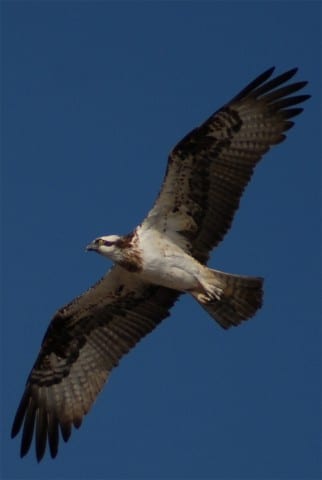Birds of prey have a pointed, curved beak for tearing flesh, very good eyes to peer out of the flight and strong feet with claws to grasp, hold on to and kill their prey.
Family Accipitridae
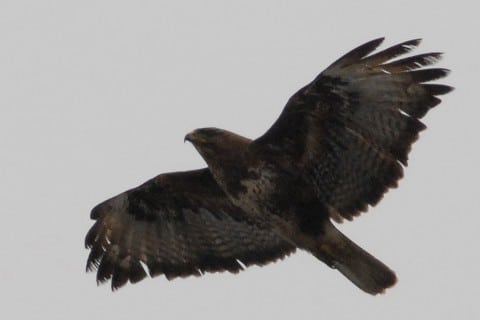
The common buzzards (Buteo buteo insularum, Ratonero común, 53 cm) occurring here form an independent subspecies. It is classified in the category “of special interest” (de interés especial), a lower protection category. Less than 1000 pairs live scattered over the islands. They can be found above all forms of vegetation up to an altitude of 2000 meters. They feed mainly on living prey such as rabbits and lizards, but they do not spurn carrion either.
Usually buzzards are the only large birds of prey in the Canary Islands, all others are smaller or much rarer (with the exception of the eastern islands where the Egyptian vulture has become more common). The silhouette could still confuse an untrained eye with that of the raven, but as soon as the mewing cry of the buzzard sounds, one knows without a doubt who one has before him.
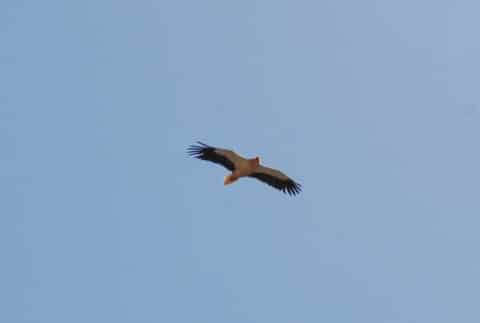
The Egyptian vulture (Neophron pernocterus, Alimoche or Guirre, 65 cm) still is to be found occasionally on the eastern islands. However, it can be seen more frequently on Fuerteventura, where thanks to breeding efforts the 20 pairs in 1999 should have become a few more.
In addition to that, for example Booted Eagles (Hieraaetus pennatus, Aguila calzada) could be observed regularly in the migration phases in the last years.
The Sparrowhawk (Accipiter nisus granti, Gavilán común, 33 cm) appears with its own subspecies on the Canary Islands and Madeira. Protection status: vulnerable. About 170 pairs live on the Canary Islands, maybe more, the tendency is positive at the moment. On the eastern islands it can only be observed in a pervasive way. Mainly it lives in forests with laurel, tree heaths and in the pine stands of the northern sides. The nests are between 5 and 16 m over the ground and every year in April, they are again equipped with 3 eggs. The sparrowhawk feeds on all forest-birds, from the goldcrest to the laurel pigeons, and don’t spurn also lizards and rodents. On Tenerife, its food consists of atlantic canaries to 46 % and on La Gomera, they eat up to 40 % of laurel pigeons, which become so big that only the up to 25 % bigger females of the sparrowhawk can carry off it.
Since 2008 the Black Kite (Milvus migrans, Milano negro) has been breeding in Gran Canaria, the Red Kite (Milvus milvus, Milano real o robapollos) is considered extinct for about 40 years.
Family Pandionidae
The western osprey (Pandion haliaetus, Guincho or Aguila pescadora, 57 cm, 145 -170 cm wingspan, 1800 grams the female / 1400 grams the male) is one of the most endangered bird species in the Canary Islands. Its population consisted of 16 – 18 pairs distributed on the different islands (2009), which only in certain years in March lay 2 – 3 eggs in huge nests and have offspring. Occasionally they can be seen hunting for fish (80% flying fish and garfish), mostly at a short distance from the coast, but they also visit inland water reservoirs. It is very important not to approach their nests during the breeding season (February to July), since they react very sensitively to annoyances by humans. Since spring 2019 the osprey is considered seriously threatened by extinction, since 18.06.20 it is listed in the Canarian Catalogue of Species Protection in this category. According to this, a plan to restore the population should be drawn up and come into force in the next three years. Since in our coastal zone two nests were still occupied 2 years ago, we are sitting so to speak on one of the last hopeful breeding grounds, which will certainly play a role in the new measures.
Family Falconidae
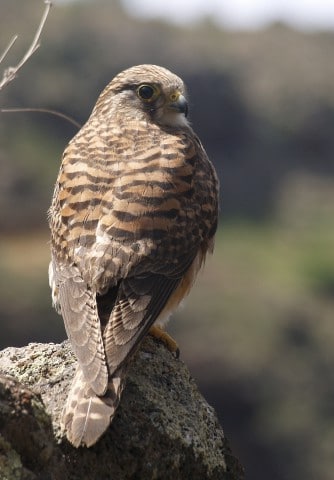
The Canarian Kestrel (Falco tinnunculus canariensis, Cernícalo, 35 cm) of the western Canaries is placed with those of Madeira and the Salvajes to an independent subtype. For the eastern islands the subspecies F. t. dacotiae was described. It is by far the most common small bird of prey on the islands and occurs practically everywhere. On the photo you can see a female, the characteristic rusty brown color is completed by a grey head in the male. It breeds between February (coastal regions) and May (high mountains) on rocky walls and usually lays 4 eggs. Mainly, it lives from insects and lizards. However, it makes up for its small size by a healthy self-confidence. Not rarely, one can observe it, how it hunts the clearly more massive buzzards or ravens, if they ventured near its nest.
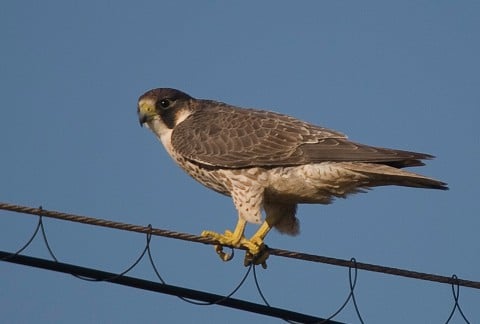
The quite rare, steel-gray Barbary falcon (Falco pelegrinoides, Halcón Tagarote, 43 cm) lives above all in remote cliffs. Their number has increased from about 20 pairs in 1993 to about 130 pairs in 2007, of which 35 were found in Tenerife. This increase may be due to the now discontinued use of DDT and other very toxic substances. They feed mainly on laurel pigeons and breed in winter.
It is not easy to distinguish between the occasional peregrine falcon, a Southern European species and the Barbary falcon. After a specialist from Germany sent me a photo of a peregrine falcon found in Gran Canaria, I received the following sympathetic explanation from the local specialist Beneharo Rodriguez, which makes it clear how many aspects play a role in the species identification (Picture on the power pole, below):
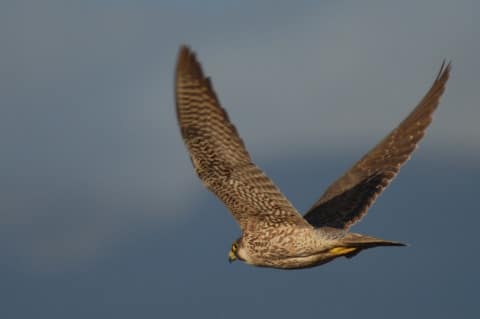
Very interesting bird. It really looks like a Peregrine Falcon (F. peregrinus), maybe a Southern European Peregrine Falcon (F. brookei), specimens with this coloration are some on the Canary Islands, even darker. The hatching (barreado) is more or less pronounced, it even reaches to the bib (babero), which is not common in the Barbary falcon (F. peregrinoides). The cheek (mejilla) is quite small, the moustache (bigotera) broad, which indicates the peregrine falcon (F. peregrinus), but also not quite clear, possibly still in the area of the Barbary falcon (F. peregrinoides). In addition it has a very slight reddish shimmer in the neck, which is not clearly visible in the photo. A few on the Spanish mainland look like this. Otherwise the back is quite dark, which rather points to peregrine falcon (F. peregrinus). In summary, I think it is an “extreme” Barbary Falcon (F. peregrinoides), and there are some that breed in GC or on other islands.
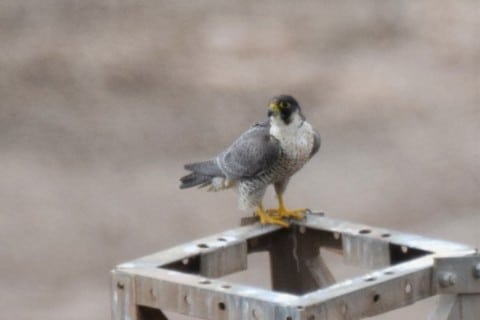
The dark grey colored Eleonora’s falcon (Falco eleonorae, Halcón de Eleonor, 38 cm) lives only on Lanzarote and the offshore islets. They move between end of October and May to East-Africa and Madagascar. About 200 pairs spend the summer on the islands and hunt mainly small migratory birds (melodious warbler, common whitethroat, willow warbler, etc). In late July and early August, they place their nests in small hollows or niches, so that the migratory birds pass by on their autumnal migration to Africa as they grow up.


